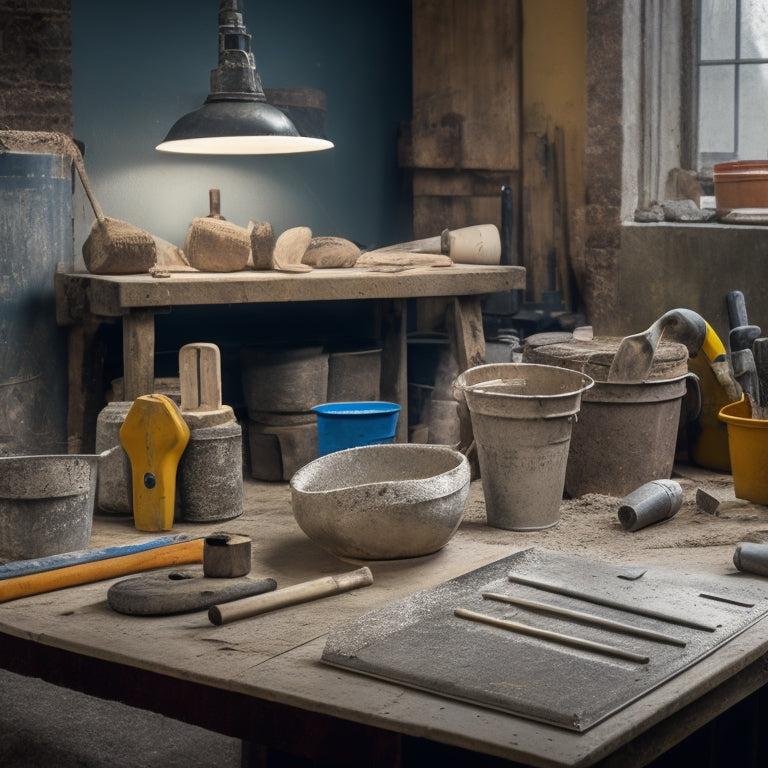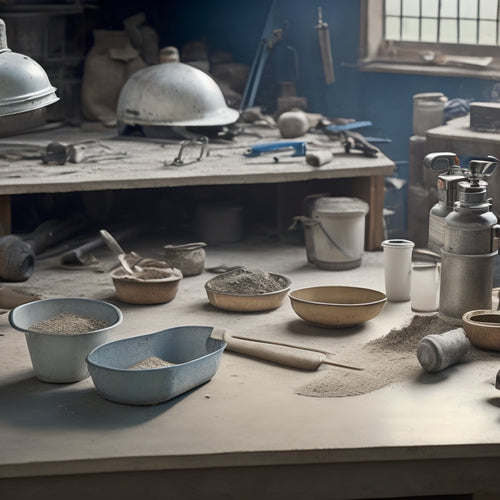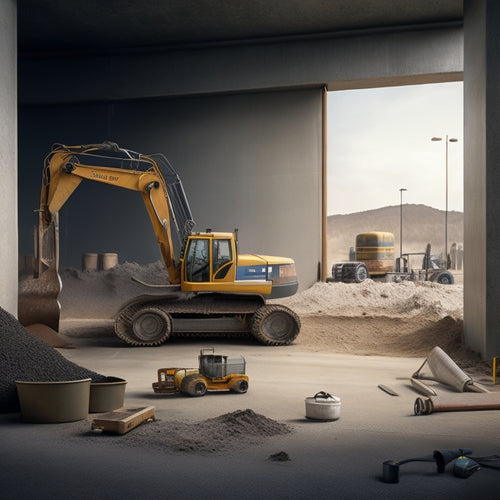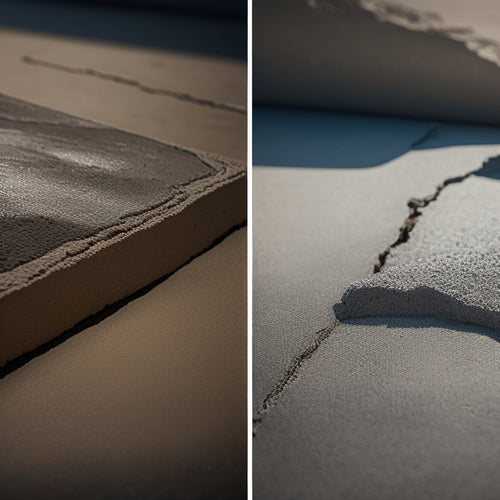
What Tools Do Professionals Use for Concrete Repair
Share
As you prepare for your concrete repair project, you'll need a range of hand tools, including sturdy trowels, mixing sticks, and wire brushes, to guarantee precise control and efficient removal of old concrete. Power tools like concrete mixers, surface grinders, and dustless grinders will speed up the process and improve finish quality. Specialized tools, such as high-pressure injection pumps and diamond grinders, may also be necessary for specific tasks. Additionally, you'll need to prioritize tool maintenance, safety equipment, and measuring devices to guarantee accuracy and safety. By having the right tools at your disposal, you'll be well-equipped to tackle even the most complex repairs, and exploring each of these categories will reveal the precise solutions you need to achieve a successful outcome.
Key Takeaways
- Professionals use essential hand tools like trowels, mixing sticks, and wire brushes for spreading, mixing, and preparing concrete surfaces.
- Power tools like concrete mixers, surface grinders, and dustless grinders improve project speed and finish quality in concrete repair projects.
- Specialized tools like high-pressure injection pumps, precision spray guns, and diamond grinders are used for unique situations and complex repair techniques.
- Tool maintenance and repair practices, such as regular cleaning and storage, are crucial to prolong tool lifespan and performance.
- Safety equipment like personal protective gear, site safety measures, and good ventilation are essential for protecting workers during concrete repair projects.
Essential Hand Tools for Repair
Your concrete repair project's success hinges on having the right hand tools. Without them, you'll struggle to achieve professional-grade results. To guarantee a strong bond between the old and new concrete, you need a variety of hand tools specifically designed for the task.
For mixing and applying concrete, you'll need a sturdy trowel, a mixing stick, and a bucket. The trowel's curved edge helps spread and smooth out the mixture, while the mixing stick guarantees thorough blending of the ingredients. A bucket with a non-slip handle and measuring marks facilitates accurate mixing techniques.
Before applying new concrete, thorough surface preparation is essential. A wire brush and a scraper come in handy for removing old, loose concrete and dirt. A putty knife helps to fill small gaps and holes, creating a smooth surface for the new layer.
Power Tools for Efficient Repair
Nearly 80% of concrete repair projects require the use of power tools to expedite the process and achieve a superior finish. As a professional, you know that having the right power tools can make all the difference in getting the job done efficiently and effectively.
When it comes to mixing concrete, you'll need a reliable concrete mixer that can handle large batches with ease. Look for a mixer with a robust motor and a durable drum that can withstand heavy use.
For surface preparation, a surface grinder is an essential tool. These grinders use rotating discs to remove old coatings, smooth out rough surfaces, and prepare the concrete for repair.
When choosing a surface grinder, consider the size of the area you need to cover and the level of aggression required for the job. You may also want to invest in a dustless grinder to minimize airborne particles and improve air quality on the job site.
Specialized Tools for Unique Situations
In concrete repair projects that fall outside the norm, specialized tools become essential to achieving a successful outcome. When dealing with complex repair techniques, such as injecting epoxy into cracks or applying polyurethane coatings, you'll need tools that can handle unique demands.
For instance, you may require a high-pressure injection pump to force epoxy into tight crevices or a precision spray gun to achieve an even coat of polyurethane.
In situations where surface preparation is critical, specialized tools like scarifiers or shot blasters can help you achieve the desired surface profile. These tools allow you to control the level of surface roughness, ensuring a strong bond between the old concrete and the new repair material.
Additionally, tools like diamond grinders or planetary grinders can be used to polish or refinish the surface, restoring its original appearance. By having access to these specialized tools, you can tackle unique repair projects with confidence, knowing that you have the right equipment to get the job done efficiently and effectively.
Tool Maintenance and Repair
As you've selected the right specialized tools for your concrete repair project, it's now essential to guarantee they remain in optimal condition to achieve consistent results.
Tool maintenance and repair are critical steps in ensuring your tools continue to perform effectively throughout the project. Regular tool cleaning is necessary to prevent the buildup of debris and concrete residue, which can compromise the tool's functionality and longevity. You should clean your tools after each use, using a wire brush or cloth to remove any excess material.
Proper tool storage is also important in maintaining the condition of your tools. You should store your tools in a dry, protected area, away from direct sunlight and extreme temperatures. This will prevent rust and corrosion, ensuring your tools remain in good working order.
Additionally, consider organizing your tools in a designated toolbox or storage container, making it easier to access and transport them to the job site.
Safety Equipment for Protection
While working with concrete repair tools, you're exposed to hazardous materials, loud noises, and physical demands that can put your safety at risk. To mitigate these risks, it's crucial to wear personal protective equipment (PPE) that covers your entire body. This includes hard hats, safety glasses, earplugs, dust masks, gloves, and steel-toed boots.
Confirm your PPE is in good condition, properly fitted, and worn correctly to maximize its effectiveness.
Moreover, site safety is critical to preventing accidents and injuries. Establish a safe working zone by cordoning off the area with warning signs and barriers. Ascertain good ventilation to prevent inhaling hazardous fumes and particles.
Implement a clean-as-you-go policy to prevent slips, trips, and falls. Regularly inspect your tools and equipment to identify potential hazards and take corrective action.
Measuring and Testing Devices
Your concrete repair project's success hinges on accurate measurements and thorough testing. To guarantee precise calculations, you'll need a laser distance meter. This device allows you to quickly and accurately measure distances, widths, and heights, streamlining your workflow and reducing errors.
Moisture meters are another essential tool for concrete repair professionals. These devices detect moisture levels within the concrete, helping you identify potential issues before they become major problems. By measuring moisture levels, you can determine the best course of action for your repair, whether it's applying a waterproofing coating or installing a drainage system.
Other measuring and testing devices you may need include ultrasonic thickness gauges, which measure the thickness of concrete, and rebound hammers, which assess the surface hardness of the concrete.
These tools provide valuable insights into the condition of the concrete, enabling you to develop an effective repair strategy. By investing in these measuring and testing devices, you'll be well-equipped to tackle even the most complex concrete repair projects.
Advanced Technology for Inspection
Three key technologies have revolutionized the concrete inspection process: ground-penetrating radar, infrared thermography, and acoustic emission testing.
You'll use these advanced tools to identify defects, cracks, and weaknesses in concrete structures, guaranteeing accurate assessments and effective repairs. Ground-penetrating radar sends electromagnetic pulses into the concrete, generating detailed images of subsurface features.
Infrared thermography, on the other hand, detects temperature anomalies, indicating potential issues like delamination or moisture intrusion. Acoustic emission testing involves placing sensors on the structure's surface to detect high-frequency sounds generated by cracking or damage.
You can also leverage drone inspections to survey large areas quickly and safely. Equipped with thermal imaging cameras, drones can capture detailed thermal data, helping you pinpoint areas of concern.
These technologies enable you to gather precise data and make informed decisions about concrete repair strategies. By incorporating advanced inspection tools into your workflow, you'll reduce the risk of misdiagnosis, minimize repair costs, and guarantee long-term structural integrity.
Frequently Asked Questions
Can I Use Household Materials for Concrete Repair?
You can attempt to use household alternatives for concrete repair, but be cautious; while DIY methods might seem tempting, they often lack the precision and effectiveness of professional-grade tools, potentially leading to subpar results and further damage.
Do I Need Licenses or Certifications for Concrete Repair?
When you're repairing concrete, like in the case of a cracked warehouse floor, you'll need licenses and certifications to guarantee you're using proper repair techniques and safety protocols, such as OSHA compliance, to avoid accidents and guarantee a durable fix.
How Long Does a Typical Concrete Repair Project Take?
You'll find that project duration varies depending on the repair techniques employed, with simple patching taking mere hours, while complex structural rehabilitations can span weeks or even months, requiring meticulous planning and execution.
Can I Repair Concrete in Extreme Weather Conditions?
You're not a concrete superhero, able to defy extreme temperatures and weather considerations, but with the right knowledge, you can still repair concrete in harsh conditions, albeit with extra precautions and specialized techniques that'll make you a master of weather-resilient concrete repair.
Are There Any Environmental Concerns With Concrete Repair?
When you undertake concrete repair, you must consider environmental concerns, ensuring sustainability practices are integrated into your process, such as using eco-friendly materials, reducing waste, and minimizing site disturbance to maintain ecological balance.
Conclusion
As you wrap up your concrete repair project, remember that having the right tools is only half the battle. It's like having a trusty sword in your arsenal - it's useless if you don't know how to wield it. Invest time in mastering your tools, and don't be afraid to seek out new ones as technology advances. With the right combination of skills and tools, you'll be the concrete repair master of the modern era, building structures that will stand the test of time, like the ancient Roman Colosseum.
Related Posts
-

What Tools Do You Need for Concrete Success
For concrete success, you'll need a range of essential power tools, including rotary hammers, angle grinders, concret...
-

Why You Need Affordable Concrete Wall Construction Tools
You need affordable concrete wall construction tools to guarantee a profitable project, as the cost of equipment can ...
-

What Tools Ensure Strong Concrete Adhesion at Home
You'll need the right tools to guarantee strong concrete adhesion at home. For surface preparation, use concrete surf...


